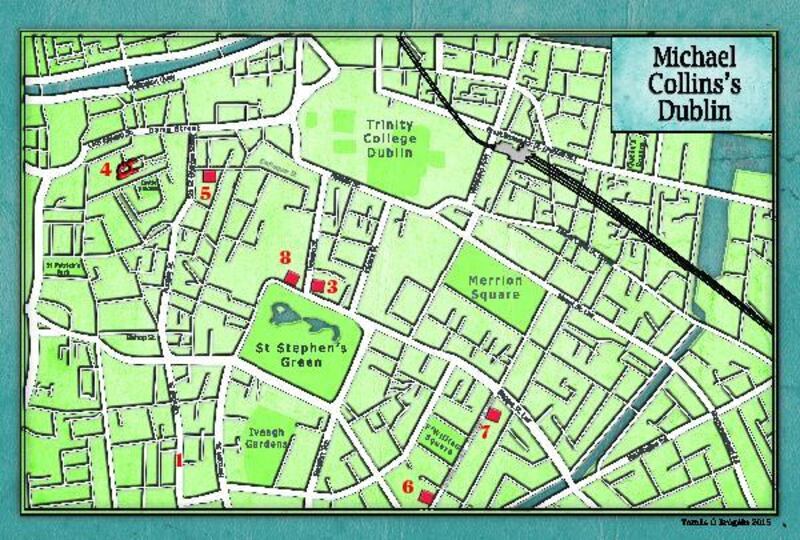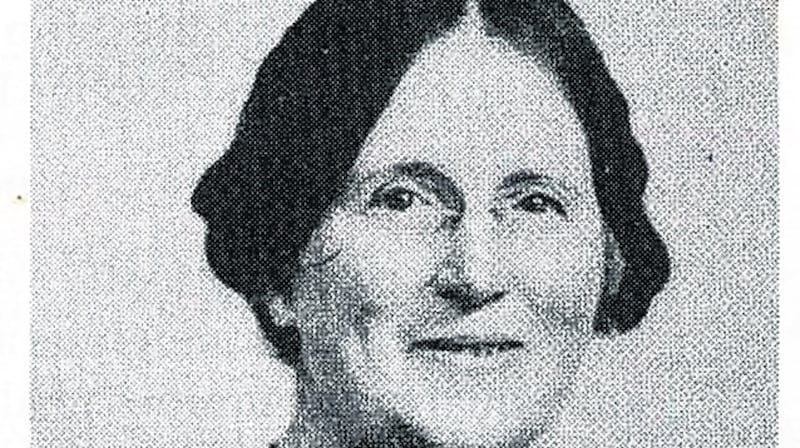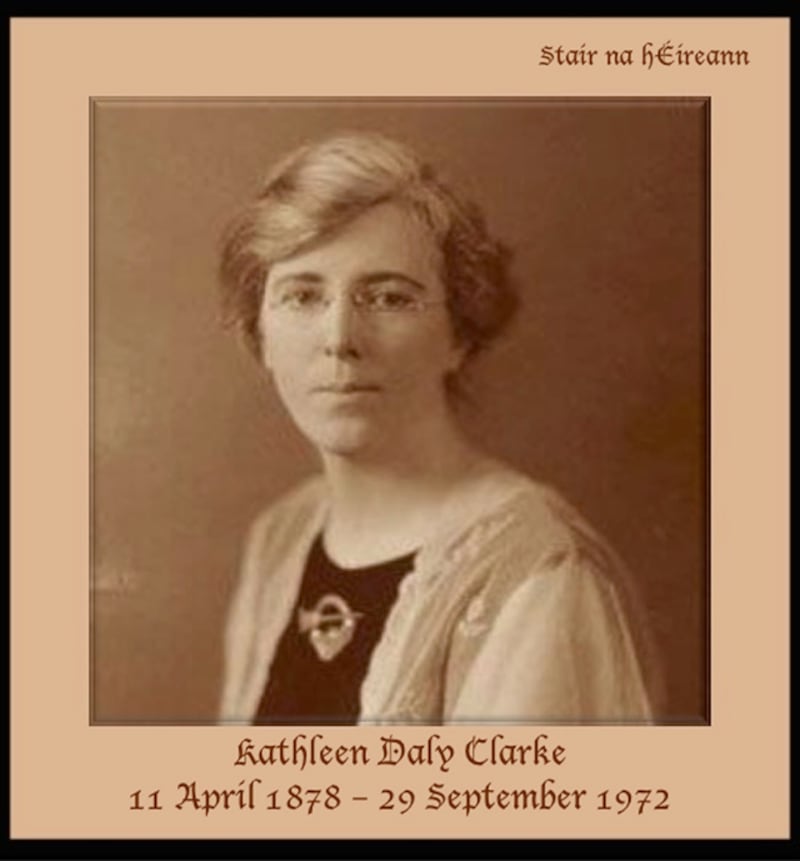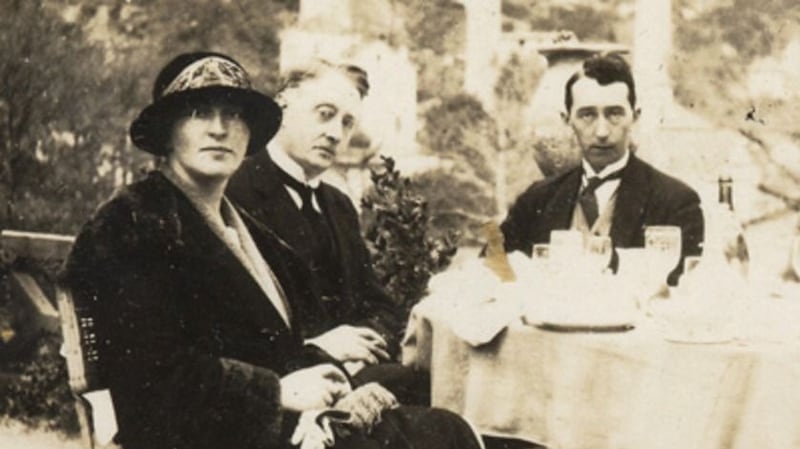The commitment of women before, during and after the Easter Rising of 1916 helped to bring the Irish nation to support the separatist movement. The widows of those executed at Kilmainham Gaol after the Rising did more to bring attention to the independence movement than any other group.
The widows and female relatives of the captives often filled the voids in leadership and ensured Irish independence did not die with their loved ones. Some of them they began their own War of Independence while many of the men were still imprisoned.
Michael Collins simply would not have been able to operate without the aid of his women spies and couriers. He had grown up in a family dominated by women – all were strong and resourceful and throughout his life he respected such women. He had a small army of women working for him as secretaries, typists, and couriers.
From 1918, Collins was on the run and he slept all over Dublin. Most of those safe-houses were run by women, and Collins could not have lived without them. Most were hospitable women, and their work required nerves of steel.
They treated wounds and provided food and shelter. They faced interrogation or the ransacking of their homes by the British. This they did day after day, and in most cases brought up their young families as if this were the normal way of life.
Below are some of the key Dublin locations where “Collins’s women” lived or worked.

1. Camden Street Lower
This was the location of Nora (Mrs Padraig) O’Keefe’s restaurant, The Farm Produce. Collins often lunched here and used it as an interim office.
Evelyn Lawless worked for Collins here as one of his secretaries. She usually worked alone here until the summer of 1920 when she left to enter a convent.
The stories of many of the women who assisted Collins are told in witness statements and pension applications. In her statement, she wrote:
“In the first week of June 1920, I gave up the work to make preparations for entering a convent. Before I left, Mick – who did not feel secure in Camden Street (I am not sure whether it was not even raided sometime we were not there) – was preparing offices in Mary Street over Robinson’s, the seed merchants. It was a busy thoroughfare and therefore also likely to be free from observation by the military authorities.
“I never worked there, but I paid a couple of visits to it as I kept in touch with Mick Collins until the date of my entry into the convent. When I was leaving, he sent me a cheque for £25 and wrote me a letter expressing his good wishes and his appreciation of my work.”
2. 37 Charlemont Street
St Ultan’s Children’s Hospital was founded in 1919 (with £70 and two cots) by Dr Kathleen Lynn and Madeleine ffrench-Mullen.
During the Rising, Dr Lynn was the Officer Commanding at the City Hall garrison after both Seán Connolly and Seán O’Reilly had been killed. Ffrench-Mullen was in charge of the Irish Citizen Army medical detachment in St Stephen’s Green.
Dr Lynn was always a republican and often treated IRA/Volunteers without the police knowing.
In 1918, Dr Lynn was one of those imprisoned during the “German Plot”, to launch a rebellion during the first World War, and was released later that year to treat patients in the influenza epidemic. As a result of her republican activities, and her provision of medical aid to rebels, she was considered “on the run”.
She always said she “evaded capture by dressing like a lady, in my Sunday clothes and feather boa, and by walking instead of cycling”.

In April 1921, she was called to one of Collins’s offices because it had been raided. Collins’s secretary Patricia Hoey and her mother lived upstairs in the house at 5 Mespil Road. Hoey had her mother fake a heart attack and called for Dr Lynn. Hoey then slipped Lynn a message to get to Collins.
3. 21 Dawson Street
This was the home of Eileen McGrane, a lecturer at the National University (now UCD).
Collins, Arthur Griffith and others came here from time to time for meetings at a small room in the centre of the flat. It was a part-time office for Collins and Ernie O’Malley during the War of Independence.
The house was raided on December 31st, 1920. McGrane was imprisoned in Mountjoy Prison, then sent to Walton prison in Liverpool, before being returned to Mountjoy.
A bundle of Collins’s documents was found in that raid, after he foolishly left them here. These included many of the documents taken from Dublin Castle, and those of the ‘G’ Division, as well as a Dublin Metropolitan Police headquarters daybook that he had carried from a raid on Great Brunswick Street.
It demonstrated a weakness of Collins: he hated to part with files, even when they ceased to be useful, and he never took sufficient precautions to ensure that the people referred to in the files could not be identified.
This was the first intimation the castle had of the effectiveness of Collins’s recruitment within their own ranks, and they began a long process of elimination that led them to Éamon (Ned) Broy. Some documents traced to Broy were found here leading to his arrest.
McGrane was taken to Dublin Castle where she was interrogated by Ormonde Winter. He was sure she would talk to him but she spoke not one word in 1½ hours.
4. Dublin Castle
Sir James MacMahon was director of the Posts and Telegraphs Office
in Dublin from 1918-1919. He called in Nancy O’Brien, Collins’s second cousin, who worked in the post office.
He pointed out that the management knew of her dedication and work, and wanted to promote her within the department. He explained that they knew that Collins had information even before the officers to whom it was sent had it. Because of her abilities MacMahon was going hire her to decode messages in his office.
When told of her being given the job, Collins said: “Well, Christ, I don’t know how they’ve held their empire for so long. What a bloody intelligence service they have.”
O’Brien had moved to London at the same time as Collins in 1906, and they were always very close. As a spy, she was invaluable to Collins and she would often spend her lunchtime in the ladies’ toilet copying papers to give to him later.
Once, when Collins berated her for not finding a message he was particularly interested in, she turned on him and gave out to him. Later that night, he went to her home in Glasnevin and apologised – leaving a present of her favourite bulls-eye candies.
On one occasion when she was going to Cork because her father had passed away, Collins asked her to complete a mission for him. He had her carry a load of guns that had just come in from England in her luggage. She had a policeman help her with the very heavy case. Later, O’Brien married Johnny Collins (Michael’s brother) after Johnny’s first wife died in January 1921 leaving eight children.
5. 10 Exchequer Street

The office of the Irish National Aid Association, first under the direction of George Gavan-Duffy and Alderman Patrick Corrigan, combined with Kathleen Clarke’s Irish Volunteers Dependent s’ Fund to form the Irish National Aid and Volunteers Dependents’ Fund.
Clarke hired Collins to work here after he was released from Frongoch interment camp, starting on February 19th, 1917, at a salary of £2.10s per week. Collins was also the Irish Republican Brotherhood “centre” (leader) for the Dublin area. Both these posts were paid positions.
This job gave Collins access to the people who were central within the complex network of parish committees throughout the country and he ensured that the work of the fund was meticulously recorded. Collins also had access to information and, as information represented power, he was now at the centre of intelligence regarding the fast-changing political arena in Ireland.
Batt O’Connor, an ex-prisoner with Collins in Frongoch, recalled that after the prisoners returned home, they often gathered around the office to plead their cases. He recalled:
“The place was packed with the Frongoch crowd and there was no sitting accommodation. When I entered, Joe Gleeson came to me and said Michael Collins was the right man for the job but he was not known. He suggested that when names were proposed we should distribute ourselves throughout the room and call ‘Michael Collins’. I got standing on a chair and Joe on another.
“People said some man was wanted who knew who was who. Joe shouted ‘Collins’ and others followed and that carried the crowd. The committee of women, Mrs Tom Clarke, etc, did not know Michael Collins but arranged the interview.
“The committee was impressed by his ability, but nettled by his apparent conceit. Nevertheless, Ms Clarke’s views were definitive.”
6. 41 Fitzwilliam Place

This was the home of Dr Brig id Lyons Thornton. In 1919-1921, she was attending medical school in Galway, and later was a doctor at Mercer’s Hospital. Throughout the period, she was a courier for Collins to Longford and Galway, carrying weapons, ammunition and documents. Whenever confronted on a train or at a roadblock, she wrote: “I had recourse to a prayer and a piece of feminine guile.”
In 1921, she was sent to Mountjoy Prison several times to relay Collins’s messages to Seán Mac Eoin regarding an escape. As a woman and as a doctor, she never caused any suspicion.
It was also thought she would be the best one to assess Mac Eoin’s physical condition. She recalled she was summoned to 46 Rutland (Parnell) Square to meet Collins. “I took to the air,” she wrote. “I was never so excited or thrilled in my whole life.” She continued to see Mac Eoin until July, even though none of the escape plans came to fruition.
She was commissioned in the Medical Services of the National Army in 1922, thus earning the distinction of being the only woman to serve in the Army at the time. Ironically, since she had been imprisoned there after the Rising, in December 1922, Dr Lyons was posted to Kilmainham Gaol as the medical officer to the republican women prisoners.
The prisoners there were mainly members of Cumann na mBan who now regarded their erstwhile colleagues as “less than the lowest British Tommy”.
“Being sent as medical officer to Kilmainham was anything but a happy assignment for me. Many of those imprisoned there I had known in the Anglo-Irish War which made it sadder still for me and often extremely embarrassing.
“But the crowning tragedy came one night when I was called to see a new prisoner. Of all people, it was Mrs Tom Clarke. ‘We meet in strange places,’ she said. She was hurt to meet me there, and I was hurt to meet her. In every way, it was all too, too cruel.
“She was already in poor health, and twice before she had been brought into these awful dungeons to say goodbye, first to her husband, and then to her only brother, Ned Daly, before they were executed.
“I did all I could to make things easier for her. We’d always been such great friends, with me and my aunt and my uncle.”
7. 31 Fitzwilliam Street Upper
This was a house owned by Maeve McGarry. The home was used to “shelter” a Dáil department for Collins during the War of Independence. It was raided on April 13th, 1921.
McGarry wrote in her witness statement that Collins and Eamon de Valera visited her home prior to de Valera going to London.
“The night before he travelled to London, Collins came, and the two of them spent hours walking up and down in the garden discussing things. De Valera and Collins were devoted to each other. Collins worshipped the ground that de Valera trod on and, while de Valera was in America, Collins went down to Greystones to Mrs de Valera every week to see that all was well there and to bring her her husband’s salary.
“De Valera was equally fond of Collins. Some years later, when he came to 31 Fitzwilliam Street to look for consulting rooms for his son, he asked to see the room which Collins used to use.”
8. 8 St Stephen’s Green
Molly O’Reilly was employed at the Hibernian United Services Club and became an invaluable intelligence source for Collins.
O’Reilly began working undercover in the club in 1918, and she gathered intelligence on British officers who frequented the club, supplying Peadar Clancy with their names and private addresses.
When things slackened off at the club, she found out that the officers were now going to the Bonne Bouche in Dawson Street for dancing, and she subsequently transferred there.
She gathered information on officers and identified 30-35 secret service men, again supplying Clancy with names and addresses. It was a regular occurrence that officers hung up their guns in the gentlemen’s room while dancing, and she passed that information to Clancy.
This is an edited extract from Michael Collins: Dublin 1916-22, by Joseph EA Connell jnr, published by Wordwell













